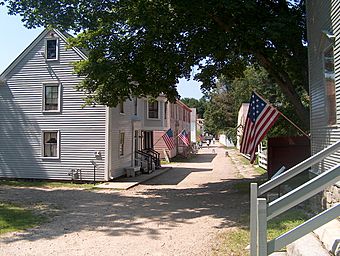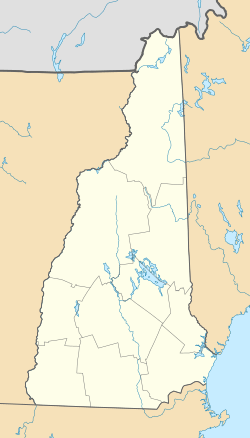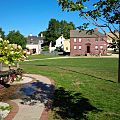Strawbery Banke facts for kids
Quick facts for kids |
|
|
Strawbery Banke Historic District
|
|

Jefferson Street within the Strawbery Banke district
|
|
| Location | Portsmouth, NH Bounded by Court and Marcy Sts. and both sides of Hancock and Washington Sts. |
|---|---|
| NRHP reference No. | 75000236 |
| Added to NRHP | June 20, 1975 |
Strawbery Banke is a special outdoor museum in Portsmouth, New Hampshire. It's like stepping back in time! This place is the oldest neighborhood in New Hampshire where Europeans first settled. It's also the earliest neighborhood still standing in Portsmouth today.
The museum has over 37 buildings that have been carefully restored. These buildings were constructed between the 1600s and 1800s. They show different styles of old architecture, like Colonial, Georgian, and Federal designs. These buildings used to be grouped around a waterway called Puddle Dock. This waterway was filled in around the year 1900. Now, that area looks like a big open space.
Contents
A Look Back in Time: History of Strawbery Banke
The story of this neighborhood began in 1630. A man named Captain Walter Neale chose this spot to build a new settlement. He named it "Strawbery Banke" because of the wild berries growing along the Piscataqua River.
First Buildings and Growth
In 1631, Humphrey Chadborn built the "Great House." This was the first permanent English building in the area. More houses were built, and many English ships came to the tidal port at Strawbery Banke. This made the area famous for its successful trade.
As the settlement grew, the neighborhood became known as Puddle Dock. This name came from the busy wharves where merchants worked. Many rich merchants from Portsmouth lived near their wharves. This made the area even more important and respected.
Saving a Historic Neighborhood
Strawbery Banke was a lively neighborhood for over 300 years, from 1630 until the late 1950s. By the end of the 1800s, the Puddle Dock neighborhood had lost its earlier importance. Many old factories and businesses were left empty.
In the 1950s, there was a plan to tear down old parts of cities to build new things. This was called "urban renewal." But a large group of people who cared about history worked hard to save the buildings in Strawbery Banke. Thanks to their efforts, the neighborhood was protected. Strawbery Banke officially opened as a museum in 1965.
What You Can See and Do
At Strawbery Banke, you can explore 17 historic houses. These houses are set up to look just as they did in the past. Staff members are there to teach you about the history of each house. They explain how people lived and how society changed over time.
Exploring the Houses
In some houses, you might meet actors dressed in old costumes. They pretend to be people from the past, showing you what life was like. In other houses, friendly guides will share interesting facts about history.
Exhibits and Demonstrations
There are also five special exhibits to visit:
- One shows what archaeologists found when they dug up the area.
- Another teaches about different building styles.
- You can learn about old woodworking tools and skills.
- There's an exhibit on how buildings were made using "post-and-beam" construction.
- Finally, you can see how people had fun and entertained themselves long ago.
During the main season, you can watch live demonstrations. These include cooking over a hearth, weaving cloth, making baskets, and even coopering (making wooden barrels). Special events are also held around major holidays.
Right across the street from the museum, you'll find Prescott Park. It has beautiful riverside gardens and fun activities. Strawbery Banke was even shown on the A&E Network in a show called Guide to Historic Homes of America, hosted by Bob Vila.
Photo gallery
-
The Parlor, Thomas Bailey Aldrich Memorial
See also










